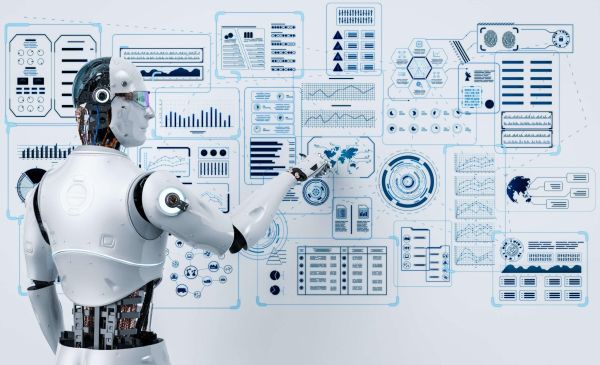Introduction
Artificial intelligence (AI) is no longer just a futuristic idea; it’s a current reality transforming our everyday work tasks. AI is becoming an essential tool, capable of automating routine tasks and providing valuable insights into complex issues, ultimately boosting productivity and efficiency. Here are seven typical work challenges that AI can help address, making your job easier and more efficient.
Managing Time and Prioritizing Tasks
One of the biggest challenges in any job is managing time effectively and prioritizing tasks. With numerous responsibilities and constant interruptions, staying organized can be difficult. AI-powered tools like virtual assistants (e.g., Siri, Alexa, or Google Assistant) and specialized software (e.g., Trello, Asana, or Microsoft To Do) can significantly alleviate this burden.
These tools can help you schedule meetings, set reminders, and even prioritize your to-do list based on deadlines and importance. Advanced AI can analyze your work habits and suggest optimal times for focused work, ensuring that you tackle high-priority tasks when you’re most productive.
For example, AI-based calendar apps can automatically reschedule meetings based on participants’ availability, or notify you of potential conflicts, helping you avoid double bookings and optimize your schedule.
Enhancing Communication and Collaboration
Effective communication and collaboration are crucial for any team’s success, yet miscommunications and missed messages are common issues. AI tools are making it easier to ensure everyone is on the same page.
Chatbots integrated into platforms like Slack or Microsoft Teams can answer routine questions, provide information, and facilitate smoother communication among team members. These chatbots can manage FAQs, offer instant responses, and free up human resources for more complex tasks.
Moreover, AI-driven translation tools like Google Translate and Microsoft Translator enable real-time communication across different languages, breaking down barriers in multicultural teams. These tools ensure that language differences do not hinder collaboration, allowing team members to work together more effectively.

Data Analysis and Decision Making
In today’s data-driven world, making sense of vast amounts of information can be overwhelming. AI excels in data analysis, transforming raw data into actionable insights.
Tools like Tableau, Power BI, and IBM Watson Analytics use AI to help you visualize data trends, identify patterns, and make informed decisions. These platforms can handle large datasets, offering predictive analytics that forecast future trends based on historical data.
For instance, in marketing, AI can analyze customer behavior data to identify which campaigns are most effective, helping marketers allocate resources more efficiently. In finance, AI can predict stock market trends or identify fraudulent transactions, aiding in risk management and strategic planning.
Automating Repetitive Tasks
Repetitive tasks are often time-consuming and monotonous, taking away valuable time that could be spent on more strategic work. AI-powered automation tools can take over these mundane tasks, allowing employees to focus on more critical responsibilities.
Robotic Process Automation (RPA) tools like UiPath, Blue Prism, and Automation Anywhere can automate data entry, invoice processing, and other routine tasks. For example, in HR, RPA can handle onboarding processes, from collecting necessary documents to setting up new employee accounts, streamlining the entire process.
In customer service, AI-powered chatbots and virtual assistants can handle basic inquiries and troubleshooting, reducing the workload on human agents and ensuring quicker resolution times for customers.
Improving Customer Service
Customer service is a critical aspect of many businesses, and AI is revolutionizing how companies interact with their customers. AI-powered tools enhance customer service by providing faster, more accurate responses.
Chatbots and virtual assistants can handle a large volume of customer queries simultaneously, offering instant support. They use natural language processing (NLP) to understand and respond to customer inquiries, providing a seamless and efficient customer experience.
Moreover, AI tools like Zendesk and Salesforce Einstein can analyze customer interactions and feedback to identify common issues and improve service strategies. These insights help businesses understand customer needs better and tailor their services accordingly, leading to higher customer satisfaction.
Boosting Creativity and Innovation

While AI is often associated with automation and efficiency, it also plays a significant role in boosting creativity and innovation. AI tools can generate ideas, offer new perspectives, and even create content.
For instance, AI-driven platforms like Adobe Sensei and Canva use machine learning algorithms to help designers by suggesting color schemes, layouts, and design elements. These tools can speed up the creative process and inspire new ideas.
In content creation, AI tools like GPT-4 (the technology behind ChatGPT) can assist writers by generating drafts, suggesting improvements, and providing research assistance. These tools can help overcome writer’s block and enhance the overall quality of the content.
Enhancing Security
With the increasing reliance on digital tools and remote work, ensuring cybersecurity has become more crucial than ever. AI helps in enhancing security measures by detecting and preventing potential threats.
AI-driven security tools like Darktrace and CrowdStrike use machine learning algorithms to monitor network activity and identify unusual behavior that may indicate a security breach. These tools can detect threats in real-time and respond swiftly, minimizing the risk of data breaches.
Additionally, AI can assist in fraud detection by analyzing transaction patterns and identifying suspicious activities. This capability is particularly valuable in the financial sector, where early detection of fraudulent transactions can save significant amounts of money and protect customer data.

Embracing AI for a Better Workplace
The integration of AI into everyday work processes is transforming the workplace, offering solutions to common problems and opening up new possibilities for efficiency and innovation. By embracing these AI tools, businesses and employees can not only solve existing challenges but also unlock new opportunities for growth and development.
Adapting to Change While the benefits of AI are clear, adapting to these changes requires a proactive approach. Employees need to be open to learning new skills and adopting new technologies. Businesses, on the other hand, need to invest in training and development programs to help their workforce adapt to the changing landscape.
It’s also essential to foster a culture of continuous improvement and innovation. Encouraging employees to experiment with new tools and approaches can lead to discovering even more ways AI can enhance work processes.
Balancing Human and AI Collaboration
One of the keys to successfully integrating AI into the workplace is finding the right balance between human and AI collaboration. While AI can handle many tasks efficiently, human insight and creativity are irreplaceable. For instance, while AI can analyze data and identify trends, humans are needed to interpret these findings and make strategic decisions. Similarly, while AI can automate repetitive tasks, human oversight ensures these processes align with broader business goals.
Conclusion
AI is a powerful ally in solving everyday work problems, from managing time and enhancing communication to automating tasks and boosting creativity. By leveraging AI tools, businesses and employees can enhance productivity, improve customer service, and stay ahead in an increasingly competitive landscape.
The future of work is here, and it’s powered by AI. Embracing these changes and adapting to new technologies can transform challenges into opportunities, leading to a more efficient, innovative, and satisfying work environment. So, take the first step towards integrating AI into your daily work routine and experience the benefits of this technological revolution.
Related Posts





